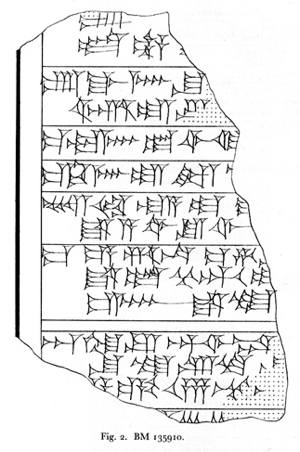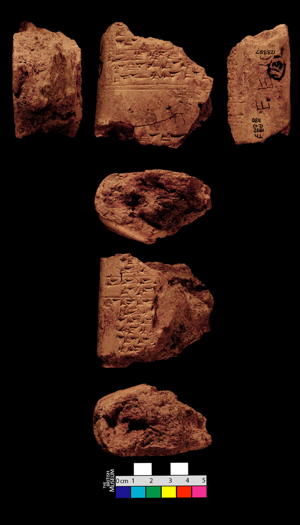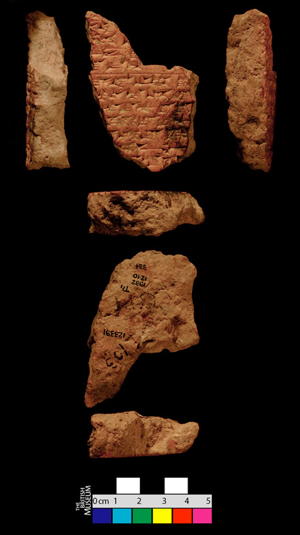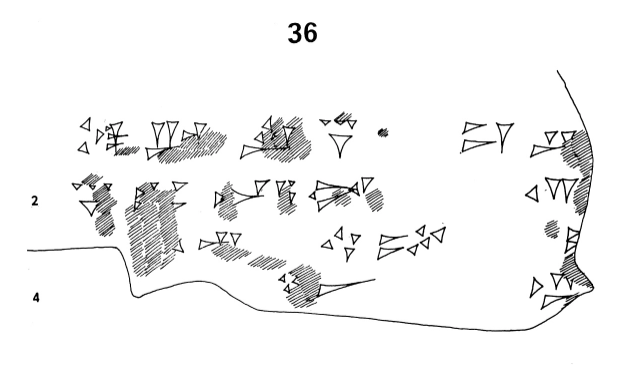Texts nos. 1001-1019
Browse the RIA 3 Corpus [/riao/ria3/pager/]
1001 1002 1003 1004 1005 1006 1007 1008 1009 1010 1011 1012 1013 1014 1015 1016 1017 1018 1019
1001

BM 135910
A fragmentary inscription is written on a piece of clay tablet of unknown provenance. The text belongs to a version of Middle-Assyrian or early Neo-Assyrian annals, which Grayson (RIMA 2, p. 71) attributes to Tiglath-pileser I.
Access the composite text [/riao/ria3/Q005956/] of Tiglath-pileser I 1001.
Bibliography
1002

BM 123387
A piece of clay tablet found at Nineveh is inscribed with a fragmentary inscription from an annalistic text attributed by Grayson (RIMA 2, p. 72) either to Tiglath-pileser I or to somebody slightly later.
Access the composite text [/riao/ria3/Q005957/] of Tiglath-pileser I 1002.
Bibliography
1003

BM 123391
A piece of clay tablet from Nineveh is inscribed with a fragmentary text from the annals of a king from eleventh to ninth century BC, and attributed by Grayson (RIMA 2, p. 73) to Tiglath-pileser I.
Access the composite text [/riao/ria3/Q005958/] of Tiglath-pileser I 1003.
Bibliography
1004
This tiny piece of clay tablet bears what seems to be the fragmentary remains of a text of Tiglath-pileser. The fragment is 5 × 3+ cm and may come from the upper right corner of a tablet, but this is rather uncertain. Although the provenance of the tablet is not recorded, it likely comes from Nineveh. The text is so fragmentary that no translation is warranted.
Access the composite text [/riao/ria3/Q005959/] of Tiglath-pileser I 1004.
Bibliography
1005
The object in question was not available for study and thus no edition is given here. The text is written on a piece of clay tablet (3.2 × 5.5+ cm), found in Nineveh. The inscription is, however, poorly preserved to the point that it is largely illegible and thus does not warrant an edition. Any link to Tiglath-pileser I is, as such, very tentative. The identification with this period is supported by the fact that the piece is covered by a white slip, however -- unlike many other tablets of this period -- the clay underneath it is not red.
Access the composite text [/riao/ria3/Q005960/] of Tiglath-pileser I 1005.
Bibliography
1006
As is the case with text no. 1005, not enough of the text written on this piece of clay tablet (5 × 8+ cm) was preserved to warrant edition. Furthermore, the object itself was not available for study. As with text no. 1005, the tablet was found in Nineveh. Any identification with Tiglath-pileser must be fairly tentative, however the script is similar to that of other inscriptions from the ninth and tenth centuries. Furthermore, the script on obv. 12' [... aš-šu]r(?)-TI.LA A [...] bears a resemblance to text no. 12 [/riao/ria3/Q005937/] line 26', although it is clear that this fragment is not a copy of that text.
Access the composite text [/riao/ria3/Q005961/] of Tiglath-pileser I 1006.
Bibliography
1007
The text presented here is written on a broken clay cone and comes from Ashur. Texts nos. 1007, 1008 [/riao/ria3/Q005963/], 1009 [/riao/ria3/Q005964/] and 1010 [/riao/ria3/Q005965/] seem likely to be exemplars of the same text, however this is not certain because it is difficult to match them line for line. As such, the text of each object is here edited separately.
Although the text is fragmentary, an identification with the reign of Tiglath-pileser I is supported by the mention of Ilu-šūma [/riao/ria1/earlybeginnings/puzurashurdynasty/ilushumma/index.html], Shalmaneser (I) [/riao/ria2/shalmaneseri/index.html], and Aššur-dān (I) [/riao/ria2/ashurdani/index.html]. It is probably the case that the structure cited in the text (although the name itself is not preserved) is the Old Assyrian Ištar Temple, as texts of Ilu-šūma refer only to this structure. The other sovereigns who mention undertaking building works on the temple are Sargon I [/riao/Q005644/], Puzur-Aššur III [/riao/Q005697/], Adad-nārārī I [/riao/ria2/Q005752/], Shalmaneser I [/riao/ria2/Q005794/], Tukulti-Ninurta I [/riao/ria2/Q005847/], and Tiglath-pileser I. This conclusion follows Grayson, RIMA 2, and Saporetti, Eponimi, as Saporetti placed the eponym Aššur-kēna-šallim at roughly the period of Tiglath-pileser I.
Access the composite text [/riao/ria3/Q005962/] of Tiglath-pileser I 1007.
Bibliography
1008
See introduction to text no. 1007.
Access the composite text [/riao/ria3/Q005963/] of Tiglath-pileser I 1008.
Bibliography
1009
See the introduction to text no. 1007.
Access the composite text [/riao/ria3/Q005964/] of Tiglath-pileser I 1009.
Bibliography
1010
See the introduction to text no. 1007. This inscription is somewhat different from texts nos. 1007, 1008 and 1009 as it is written in "archaic" script.
Access the composite text [/riao/ria3/Q005965/] of Tiglath-pileser I 1010.
Bibliography
1011

VA Ass 03238c
A broken brick from Ashur bears an unusual text. No royal name or mention of the palace nor dedication to deity begins the text. Grayson (RIMA 2, p. 78) proposed a lacuna at the top of it, but no physical trace of break is present. The scholar also attributes this brick to Tiglath-pileser I (for discussion, see RIMA 2, p. 78).
Access the composite text [/riao/ria3/Q005966/] of Tiglath-pileser I 1011.
Bibliography
1012
Two brick fragments from Nineveh bear this very broken and fragmentary text. The royal name in the first line leaves some room for doubt, as it could be that of either Tiglath-pileser (I) or Tukultī-Ninurta (II) [/riao/ria2/tukultininurtaii/index.html]. According to Thompson, the bricks were found in "Chamber II, N.E. wall" in the "Asn. Palace". Unfortunately the fragments in question have not been located.
Access the composite text [/riao/ria3/Q005967/] of Tiglath-pileser I 1012.
Bibliography
1013
This stele comes from the row of steles at Ashur, but is badly preserved to the degree that none of the signs can be read with much confidence. As such, it cannot be ascribed to any one king with certainty. Andrae puts forward the theory that it is a stele of Ashurnasirpal II [/riao/ria4/index.html], due to its position relative to other steles that it has been possible to identify. However, Herzfeld prefers identification with Tiglath-pileser I and, as a stele of Ashurnasirpal II [/riao/ria4/index.html] of this type has already been recovered (see Ashurnasirpal II text no. 108 [/riao/ria4/Q004562/]), Herzfeld's theory seems more probable. As the object is not legible, no edition is given here.
Access the composite text [/riao/ria3/Q005968/] of Tiglath-pileser I 1013.
Bibliography
1014
This clay tablet fragment measures c. 6 × 2.5 cm and was found in Ashur. It is a school copy of an inscription dedicating an object to the goddess Ninlil. It is therefore possible tentatively to link the text to Tiglath-pileser I's reign, as he is the only monarch of the early first millennium (1114-859) who definitely worked on the Ninlil shrine in Ashur (see text no. 1 [/riao/ria3/Q005926/] iv 32-39).
Access the composite text [/riao/ria3/Q005969/] of Tiglath-pileser I 1014.
Bibliography
1015
The texts nos. 1015-1021 all come from Nineveh and are currently housed in the British Museum. They are all written on clay tablet fragments that are too small or poorly preserved to justify an edition.
Access the composite text [/riao/ria3/Q005970/] of Tiglath-pileser I 1015.
Bibliography
1016
See introduction to text no. 1015.
Access the composite text [/riao/ria3/Q005971/] of Tiglath-pileser I 1016.
Bibliography
1017
See introduction to text no. 1015.
Access the composite text [/riao/ria3/Q005972/] of Tiglath-pileser I 1017.
Bibliography
1018
See introduction to text no. 1015.
Access the composite text [/riao/ria3/Q005973/] of Tiglath-pileser I 1018.
Forthcoming
Bibliography
1019
See introduction to text no. 1015.
Access the composite text [/riao/ria3/Q005974/] of Tiglath-pileser I 1019.
Bibliography
Nathan Morello, Jamie Novotny & Poppy Tushingham
Nathan Morello, Jamie Novotny & Poppy Tushingham, 'Texts nos. 1001-1019', The Royal Inscriptions of Assyria online (RIAo) Project, The RIAo Project, a sub-project of MOCCI, 2023 [http://oracc.museum.upenn.edu/riao/thekingdomofassyria1114884bc/tiglathpileseri/texts10011019/]